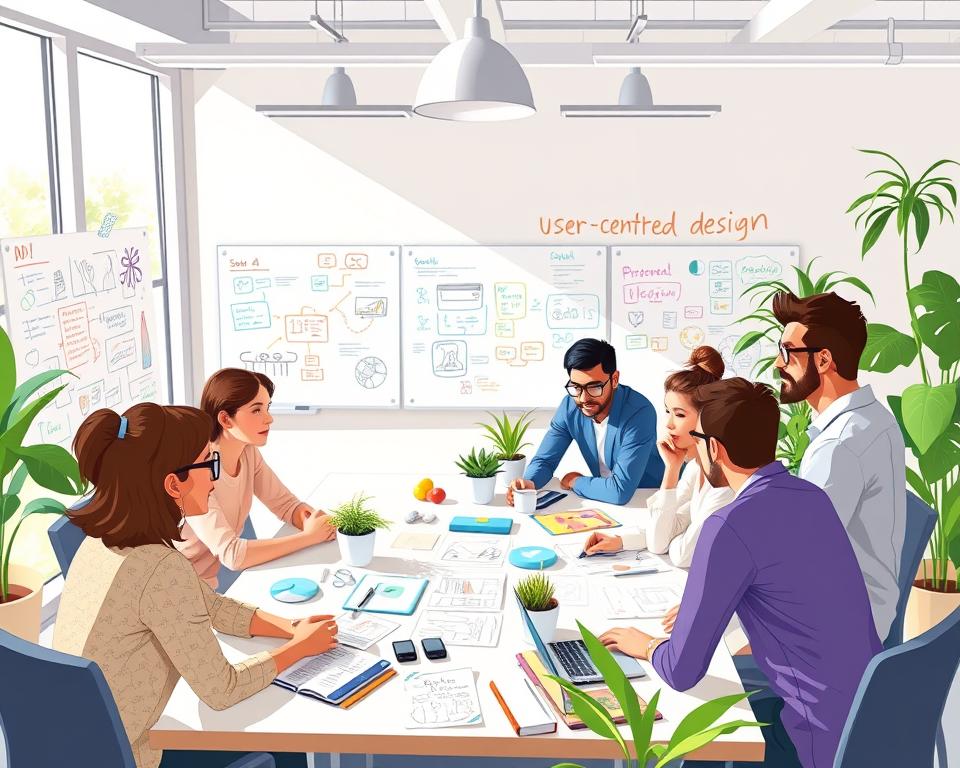Have you ever wondered how much employee participation contributes to the success of a business’s design strategy? Across Australia, a movement is taking hold—one that prioritises insight over hierarchy, collaboration over dictation, and co-design over siloed creation. But is this approach more than a trend? Could it be a defining element of the modern Australian workplace?
The concept of involving employees in design decisions resonates deeply with the spirit of inclusive design and design thinking. By approaching problems with the dual lenses of empathy and pragmatism, businesses in Australia engage in user-centered design, not just as a process, but as a holistic philosophy that empowers and celebrates the collective wisdom of their workforce.
With a keen focus on collaborative design, these strategies go beyond mere aesthetics—offering a pathway to effective, human-focused solutions that resonate with both employees and consumers. In a landscape keen on innovation, Australian organisations are finding value in turning to those who are closest to the problems: their employees. But how does this translate into tangible outcomes, and what does it mean for industry standards and competitive advantage?
As we dive deeper into this concept, insights emerge from the real-world application of employee inclusion—a cornerstone of modern strategic thinking embraced across diverse sectors. From the bustling corporate offices in Sydney to the culturally-rich Indigenous communities, such as those impacted by the Yuwaya Ngarra-li partnership, the common thread is clear: incorporating employee participation in design decisions isn’t just beneficial; it’s essential for driving social impact and business success.
Reflecting on the principles laid out by the New South Wales government’s Social Impact Assessment Guideline and the proactive efforts of organisations like DEG and QYAC, one can witness the profound influence of well-structured decision-making systems. In fact, the consultative ethos is reflected in the core of Australian legislative guides—such as the CATSI Act—that navigate the complexities of governance and community engagement.
It’s evident that the wave of change towards more democratic, inclusive and effective decision-making within organisations isn’t just a ripple—it’s a swell. And with resources like the Psychosocial Hazard Work Re-Design Tool (PHReD-T) and the insights provided by the Taungurung Land and Waters Council decision-making guide, businesses have never been more equipped to steer towards a more culturally sensitive and psychologically safe workplace, bolstering not just the economy but the community fabric as a whole.
The Importance of High-Quality Decision-Making in Australian Business Success
In the dynamic landscape of Australian businesses, the quality of decisions has emerged as a critical determinant of business success. Recent studies, including a comprehensive survey by Decision Design of over 1,000 decision-makers, underscore the profound impact that executive decision-making has on performance indices such as profitability, consumer trust, and market competitiveness.
Statistical findings reveal that only 60% of crucial business decisions hit their intended outcomes, leaving a substantial 40% that falter, eliciting increased operational costs and reduced sales figures. Specifically, poor leadership decisions have been directly linked to a 58% increase in business expenses, a 40% dip in profits, and a 35% decrease in sales volumes within various sectors.
Moreover, the study highlighted that enhancing decision-making processes through behavioral sciences and evidence-based practices could potentially boost economic output by up to 40%. This data is not just a call to action for improving the current decision-making framework but a clear indication of the tangible benefits of investing in refined decision-making capabilities.
- Adopting data-driven approaches, similar to those implemented by international retailers and tech giants, has proven to multiply efficiency and customer responsiveness.
- Organizational practices such as pre-mortems, which anticipate potential failures, and a diversity of thought in decision-making forums can prevent costly errors and enhance outcome quality.
- Encouraging risk-taking in controlled environments can stimulate innovation and maintain competitive edges during crucial market transitions.
To mitigate the overconfidence often displayed by leaders, it is essential to embed systematic checks and balances that ensure diverse perspectives are considered. Such measures guard against the common pitfalls of groupthink and foster a culture where the quality of decisions is held paramount.
Ultimately, the roadmap to enduring business success in Australia hinges significantly on the ability of leaders at all levels to make informed, evidence-backed leadership decisions. This not only enhances operational efficiency but also reinstates consumer trust in the post-Banking Royal Commission era, facilitating a more robust, transparent, and flourishing business environment.

Insights on Employee Participation from Decision Design Experts
In Australia, decision design experts assert the value of embedding employee engagement and empowerment into the fabric of organizational decision-making. Involving diverse perspectives not only enhances decision quality but also drives substantial improvements in business outcomes.
Impact of Poor Leadership Decisions on Business Outcomes
Statistics reveal that 58% of poor leadership decisions in Australian businesses have led to increased operational costs. Poor decision-making, featuring biases such as overconfidence and excessive optimism, have not only resulted in a 40% loss in profit but also a 35% decline in sales. Furthermore, such decisions have negatively impacted employee engagement, with a considerable drop in both staff retention and motivation.
Improvement of Economic Output through Behavioural Decision Processes
Adopting behavioural decision processes can substantially rectify these shortcomings, potentially boosting the economic output of businesses by 40%. By addressing the common cognitive biases that plague decision-making, organizations can achieve greater accuracy in their strategic choices, leading to enhanced profitability and cost efficiency.
Dr Johann Ponnampalam, a leading expert in organizational behaviour, underscores the critical need for creative and productive decision-making in today’s economic climate. He advocates for the integration of behavioural science to de-bias leadership decisions and emphasizes the importance of empowerment through active participation. Dr Ponnampalam champions the approach of engaging employees in design workshops and collective decision processes, highlighting how these strategies not only foster sustainability but also drive organizational success.
In conclusion, whether it’s through enhancing employee participation in decision-making or leveraging behavioural psychology to improve decision accuracy, the path to organizational excellence and robust economic performance is clear. These strategies not only mitigate risks but also enhance overall business health, positioning Australian businesses to thrive in competitive global markets.
Strategies for Engaging Employees in User-Centered Design
As the business landscape continues to evolve, the necessity of involving employees in design decisions has never been more paramount. To harness the full potential of collaborative design, it is crucial to integrate employee feedback from the initial stages of the design process. This approach not only bolsters innovation but also ensures that the products and services developed are truly reflective of user needs.
Adopting a strategy centered around design thinking involves key steps that align closely with enhancing user satisfaction—a goal that has proven to result in higher retention and adoption rates. To outline our approach:
- Early Inclusion: Initiating involvement at the conception stage allows employees to contribute meaningful insights that can significantly shape the project’s direction.
- Regular Feedback Loops: Utilizing methods like surveys and interviews helps in capturing both qualitative and quantitative data that informs the design thinking process.
- Diverse Team Collaboration: Encouraging cross-functional teamwork, where members from different backgrounds come together in brainstorming sessions, leads to innovative solutions that effectively address user needs.
- Prototyping: Developing prototypes, from low-fidelity to high-fidelity, ensures that all team members can visualize and iterate on concepts before finalizing the design, thereby enhancing the collaborative design efforts.
- Usability Testing: Conducting tests with real users assists in identifying any usability issues early on, allowing for adjustments that refine the product based on direct user feedback.

These strategies are part of a broader commitment to design thinking that fosters a culture of continuous improvement and creativity. By involving employees in design decisions, companies leverage a wide array of insights that lead to more intuitive and successful products.
Remember, a user-centered approach is not just about meeting the needs of external customers but also about valuing your internal team’s input as integral to the creative process.
Indeed, the advantages of engaging employees in user-centered design extend beyond immediate project outcomes. They also contribute to a more motivated workforce, capable of driving the company towards innovation and market responsiveness. With every project, we strive to not only meet user expectations but to exceed them, ensuring that our products and services truly resonate with those they are meant to serve.
Facilitating Effective Change Management through Employee Involvement
To adeptly navigate the complexities of the change management process, incorporating a robust system of employee participation is critical. In doing so, we not only harness the collective insights and strengths of our team but also significantly enhance our ability to adapt business changes smoothly and effectively.
In our endeavour to implement meaningful and sustainable change, the role of leadership participation cannot be overstated. Leaders are the linchpins in the architecture of change management, exemplifying the adaptability and commitment needed to steer our teams through transitions.
Planning and Communicating Change with Employee Participation
Effective planning and communication form the bedrock of successful change initiatives. By engaging employees at every stage, we foster a culture of trust and inclusivity, essential for adaptive changes. Utilising employee engagement platforms such as Culture Amp and CultureMonkey enables us to measure and optimise our engagement strategies efficiently. Their insights help tailor our communications to address the specific cultural and operational nuances of our organisation.
Empowering Leadership to Support Change Management
Empowering our leaders with the right tools and skills is imperative for nurturing a supportive environment that can confront the challenges of change. Training programs from platforms like Udemy for Business and LinkedIn Learning provide our leaders with the knowledge to manage transitions effectively. Leadership participation here means being proactive in communication, providing clear directions, and supporting staff through the uncertainty of change.
Techniques for Minimising Stress and Resistance during Business Changes
Change can often be daunting, leading to resistance and stress among employees. To mitigate these responses, we break down the change management process into manageable segments, making the transition less overwhelming. Regular training sessions, real-time collaboration tools like Slack, and Microsoft Teams encourage open dialogue and constant feedback, which help in dissipating fears and clarifying uncertainties.
Moreover, the deployment of adaptability skills is crucial; fostering an environment that champions flexibility, self-awareness, and support networks makes it far easier for employees to adapt business changes fluidly and confidently.
Involving Employees in Design Decisions: The Social and Architectural Impact
As we delve into the nexus of design and social sciences, we recognize the key role employees play in shaping the social and architectural landscapes of workspaces. Our approach to design processes in Australia has evolved significantly, shifting towards a community-led design framework that acknowledges the implicit social impact of design. The concepts like proxemics and the influential frameworks introduced by environmental psychologists Rachel and Stephen Kaplan have allowed us to discern the nuanced needs of individuals in shared spaces. It has long been understood that the environment in which we work affects not only our productivity but also our well-being, making the integration of social sciences in spatial design indispensable.
In our drive for innovation and functionality, circular design thinking becomes paramount. It encompasses not only the physical aspects but also the emotional and psychological needs as defined by Abraham Maslow’s Hierarchy of Needs Theory. Employing this strategy, designs gain a balance, offering the sense of safety, mystery, and an affinity for natural elements that employees crave. By involving them in the decision-making process, we ensure that their need for belonging, dignity, and ownership is met, fostering an environment of engagement and recognition. The Bartlett School of Architecture, which leads the global rankings, has been pivotal in shaping these philosophies, especially through the research of scholars like Dr. Kerstin Sailer, who unraveled the correlation between design and sociology.
Australia’s workplace design trends, such as activity-based working, highlight the importance of understanding employee needs within open plan workspaces. Priorities such as dedicated desks, proximity to team members, storage solutions, and acoustics for privacy are crucial for employee satisfaction. Utilizing workspace satisfaction surveys, we can identify the likes and dislikes concerning their current environments, enabling a design that cultivates productivity and comfort. Additionally, analyzing occupancy data with metrics like workstation utilization informs us how to craft spaces that are both efficient and pleasurable. This data-driven approach not only benefits the employees but also speaks volumes about a company’s culture and its commitment to creating an enriching environment for its workforce.
FAQ
Q: How does involving employees in design decisions benefit Australian businesses?
A: Involving employees in design decisions fosters a culture of engagement and empowerment, leveraging their diverse perspectives for co-design and collaborative design. It leads to more innovative and effective products and services that resonate with the workforce and customers, aligning with user-centered design principles and inclusive design approaches.
Q: Why is the quality of decision-making critical to business success in Australia?
A: The quality of decisions has a direct impact on a business’s success, affecting costs, profits, and sales. Enhancing decision-making processes with insights from behavioural science can significantly improve economic output and reduce biases, thereby contributing to the overall success and sustainability of Australian businesses.
Q: What consequences can poor leadership decisions have on business outcomes?
A: Poor leadership decisions can lead to increased business costs, loss of customers, and reduced employee engagement. These negative outcomes further emphasize the importance of involving employees in decision-making through behavioural decision processes and design thinking workshops to improve economic output and business sustainability.
Q: What strategies can businesses employ to engage employees in user-centered design?
A: Businesses can involve employees from the start by integrating their insights into the decision-making framework, addressing concerns transparently, valuing their ideas, and fostering a collaborative environment through design thinking and participative workshops. This inclusive approach not only boosts innovation but also encourages ownership among the team.
Q: How can effective change management be facilitated through employee involvement?
A: Effective change management requires clear communication of the need for change, detailed and inclusive planning, and ensuring employees have the necessary skills and support. Leaders must display confidence and consistency in their messages, while offering training and resources to manage the emotional impact of change, ultimately minimizing stress and resistance.
A: Employee participation in design decisions can lead to community-led and socially impactful designs that resonate with users on both functional and cultural levels. This approach creates spaces that reflect the values and needs of the community, fostering agency and promoting sustainable architectural solutions.

